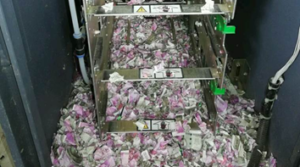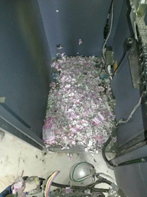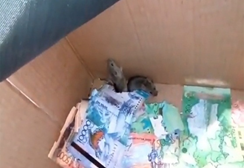Surprised reading the title?
Well, many of you would have read it in the newspaper and social media platforms about the news.
You know it’s going to be a severe economic downturn when ATMs are being closed because the rodents shred currency notes resulting in technical errors and thus the ATM is out of service.
Not only humans but even rodents seem to have a huge appetite for currency notes!
Recent news reported for this menace is grabbing everyone’s attention.
It was reported that:
Notes worth Rs 12 lakh destroyed by mice inside Assam’s Tinsukia ATM
By: Express Web Desk, The Indian Express | Guwahati | June 19, 2018
A Guwahati-based financial company named FIS: Global Business Solutions, which runs the ATM, had reportedly deposited Rs 29 lakhs inside the machine on May 19.


A different kind of demonetisation struck Assam’s Tinsukia district when mice allegedly tore to shreds notes worth Rs 12 lakhs inside an ATM belonging to the State Bank of India (SBI).
The SBI ATM (DFBK – 000196116) in Laipuli area has been shut due to technical failure since May 20. However, behind closed doors, unknown to the world, it was hosting an army of four-legged guests: Mice. On June 11, when a few repairmen visited the outlet to get the machine fixed, they were surprised to find heaps of 500 and 2,000 rupee notes shredded into tiny pieces.
According to bank officials, notes worth Rs 12,38,000 have been destroyed by the mice. A Guwahati-based financial company named FIS: Global Business Solutions, which runs the ATM, had reportedly deposited Rs 29 lakhs inside the machine on May 19. “The ATM had stopped working the following day,” a local Tinsukia-based journalist confirmed.
This is not the first case to be reported. Read more:
Mice chew through cash in Kazakh ATM
January 13, 2018
 A pair of mice snuck into an ATM in the Kazakh capital Astana, hiding from a snow storm. Bank workers were surprised when they discovered the tiny intruders and the ruined notes they had munched on during their stay.
A pair of mice snuck into an ATM in the Kazakh capital Astana, hiding from a snow storm. Bank workers were surprised when they discovered the tiny intruders and the ruined notes they had munched on during their stay.
The two were found when the machine was re-stocked with cash, and the workers recorded their odd discovery on a video.
The footage, posted on local social media, shows damaged banknotes and feces in the ATM compartment. “And here we have a mouse,” a male voice comments, as a woman lifts the cover on a box containing a pile of chewed money. To show the rodent, the man moves some banknotes aside only to find there were actually two of them, making female workers in the video squeak. “An entire mafia here,” he says.
Although the bank didn’t say how much the ‘lunch’ for the two mice had cost, local media estimated the damage at some $300.
Man makes a cash withdrawal from ATM, gets a mouse with his money
By Leigh Goessl │January 30, 2012 in Odd News
A man recently went to get some cash out of an ATM and got a surprise withdrawal.
After he pulled out his cash from the machine in Ersboda, located in northern Sweden, Gholam Hafezi didn’t get a receipt, but did get much more than he’d anticipated.
According to Swedish publication Folkbladet.nu, Hafezi had made a 700 kronor ($104) withdrawal from his account and with his withdrawal came a mouse’s tail.
At first Hafezi thought it was a shoelace, but then he realized it was a mouse tail and the rest of the body and head of the mouse was still struggling inside the machine.
“I pulled once more and then his tail came off,” said Hafezi, who rushed in to the customer help desk at the neighbouring Coop Forum grocery store for help, reported The Local, an English version of Swedish News.
This mouse claimed a more pricey residence when he took up house inside an ATM and chewed up the cash to make a nest.
ATMs seem like an odd place for mice to scurry into, but perhaps not as unusual as you’d think. Consider how flexible mice are and are able to squeeze in small places. Additionally, it is common to find mice and other small animals taking refuge in other types of machinery.
Why would have they been into the ATM? Well, the shelter is one of the reasons the rodents visited the ATM. Also, the rodents can survive on anything they can chew.
The reason why rodents are such determined chewers is that they actually chew for survival. Like several other animals of the rodent family, they have characteristic strong incisors that grow all through their lives. The chewing habit is for them, a coping mechanism to file these incisors and keep them from growing out of hand – or mouth, so just like we clip our fingernails, a rat gnaws on things in order to keep its teeth in check. Overgrown teeth are a possible problem for them. They like any surface that they can gnaw on, let the surface be metal, polymer, concrete, wood, etc.
Using mechanical traps, rat baits, glue boards, fumigation is not the way to combat this nuisance.
We need something that keeps the rodents at bay.
The solution available with C Tech Corporation to this nuisance is a onetime solution and the need of the hour because you just cannot let the cash to be chewed up by the rodents. Our products are a blend of green chemistry and smart technology.
Our product Rodrepel™ is an extremely low toxic, non-hazardous rodent aversive. This product acts through a series of highly developed intricate mechanism ensuring that rodents are kept away from the target application. Our eco-friendly products do not kill the target species but only repel them. The product is compliant with ROHS, ROHS2, ISO, REACH, APVMA, NEA, BPR, and FIFRA exempted.
The product triggers a fear response in rodents thus protecting the application. It causes severe temporary distress to the mucous membrane of the rodents due to which the pest stays away from the application. The product triggers an unpleasant reaction in case if the pest tries to gnaw away the application. After encountering the above-mentioned emotions, the animal instinctively perceives it with something it should stay away from and stores this information for future reference. The fact that certain rodents are repelled is mimicked by other rodents as well. Thus, the other rodents too stay away from the applications. The unpleasant experience is imprinted within the animal’s memory and passed on to its progeny.
Our newly developed product is in the form of spray which can be applied in every part of the ATM and it is any easy to use product. It can be sprayed on the already installed wires and cable, devices, ceiling panels, and other pest infested areas.
The products are also available in the form of a solid masterbatch, liquid concentrate, and lacquer.
The product available in the form of solid masterbatch can be incorporated into the polymeric applications like wires and cables, cash withdrawal machines, etc. Thus, making the end application rodent resistant.
The product available in liquid concentrate can be diluted in paints and can be applied to interior and exterior of the ATM. The liquid concentrate is compatible with all kinds of paints and solvents.
The already installed wires and cables from the ATM can be coated with our lacquer to protect them from the pests gnawing on these applications and thus preventing huge monetary loss. The lacquer is transparent product and it does not wear off easily.
By using our products, you can get an effective and long-lasting solution against pest nuisance.
You could thus contribute to us in using products which are eco-friendly thus causing no damage to the environment.
Contact us at technical.marketing@ctechcorporation.com if you’re facing problems with rodents and get best remedies to combat the pest menace.
Also, visit our websites:
http://www.ctechcorporation.com/
http://www.rodrepel.com/
http://www.termirepel.com/
http://www.combirepel.com/
Follow our Facebook pages at:
1] https://www.facebook.com/Combirepel-411710912249274/
2] https://www.facebook.com/Termirepel-104225413091251/
3] https://www.facebook.com/Rodrepel-120734974768048/
Follow us on our Twitter pages at:
1] https://twitter.com/rodrepel
2] https://twitter.com/termirepel
3] https://twitter.com/combirepel
